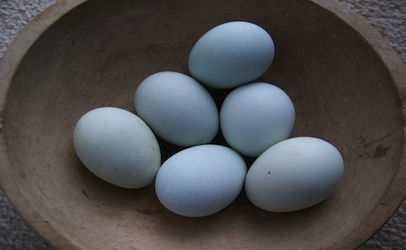Viruses can cause foodborne illnesses, but viruses can also shape the evolution and diversity of a species to create something entirely new on the menu. Take the much-in-demand blue eggs that trend-setting foodies say are tastier and better for baking than brown eggs. In its latest issue, the Public Library of Science journal PLOS ONE has created a worldwide stir by publishing a University of Nottingham study that says blue eggs originated from a genetic mutation.  In findings that are parallel to research conducted by Chinese scientists on Asian and American breeds, the School of Biology at Nottingham found that the first blue eggs were produced by the South American chicken known as the Mapuche fowl and their European descendants, the Araucana, between 200 and 500 years ago. The four-year Nottingham study is expected to help with agricultural breeding techniques that will be needed to meet the growing demand for blue eggs. The study took advantage of unique genetic resources from “heritage” (fancy poultry) breeders to identify the exact location at fine resolution of the mutation in the genome in blue egg-laying chickens. Further genetic study found the cause of the blue-colored eggshell was an ancient and harmless retrovirus in the domestic chicken. A retrovirus is simply a virus that carries the genetic blueprint in the form of ribonucleic acid (RNA). It reproduces itself in the host cell using an enzyme that turns the RNA into deoxyribonucleic acid or DNA. That’s how the genetic material from the retrovirus becomes part of the DNA of the infected cell. Blue eggs came about because the effect of the retrovirus was to leave an accumulation of green-blue bile pigment in the eggshell as it develops in the hen. “An unexpected find was the unique integration sites for the retroviruses in South American/European and Asian chickens,” said David Wragg, who led the Nottingham research project. “It shows the importance of viruses in shaping evolution and diversity of species.” “It’s quite remarkable – retroviruses are generally considered to integrate at random locations in the genome, and so the chance of retroviruses integrating at more or less the same location in two chicken populations is extremely low,” Wragg added. He says chicken owners hundreds of years ago must have noticed that trait and incorporated it into their subsequent breeding. While common to other bird species such as Robins, the researchers say only the rare native breeds of chickens produce them. The challenge for agriculture now, they say, will be to conserve and promote them.
In findings that are parallel to research conducted by Chinese scientists on Asian and American breeds, the School of Biology at Nottingham found that the first blue eggs were produced by the South American chicken known as the Mapuche fowl and their European descendants, the Araucana, between 200 and 500 years ago. The four-year Nottingham study is expected to help with agricultural breeding techniques that will be needed to meet the growing demand for blue eggs. The study took advantage of unique genetic resources from “heritage” (fancy poultry) breeders to identify the exact location at fine resolution of the mutation in the genome in blue egg-laying chickens. Further genetic study found the cause of the blue-colored eggshell was an ancient and harmless retrovirus in the domestic chicken. A retrovirus is simply a virus that carries the genetic blueprint in the form of ribonucleic acid (RNA). It reproduces itself in the host cell using an enzyme that turns the RNA into deoxyribonucleic acid or DNA. That’s how the genetic material from the retrovirus becomes part of the DNA of the infected cell. Blue eggs came about because the effect of the retrovirus was to leave an accumulation of green-blue bile pigment in the eggshell as it develops in the hen. “An unexpected find was the unique integration sites for the retroviruses in South American/European and Asian chickens,” said David Wragg, who led the Nottingham research project. “It shows the importance of viruses in shaping evolution and diversity of species.” “It’s quite remarkable – retroviruses are generally considered to integrate at random locations in the genome, and so the chance of retroviruses integrating at more or less the same location in two chicken populations is extremely low,” Wragg added. He says chicken owners hundreds of years ago must have noticed that trait and incorporated it into their subsequent breeding. While common to other bird species such as Robins, the researchers say only the rare native breeds of chickens produce them. The challenge for agriculture now, they say, will be to conserve and promote them.
Sponsored by Marler Clark
